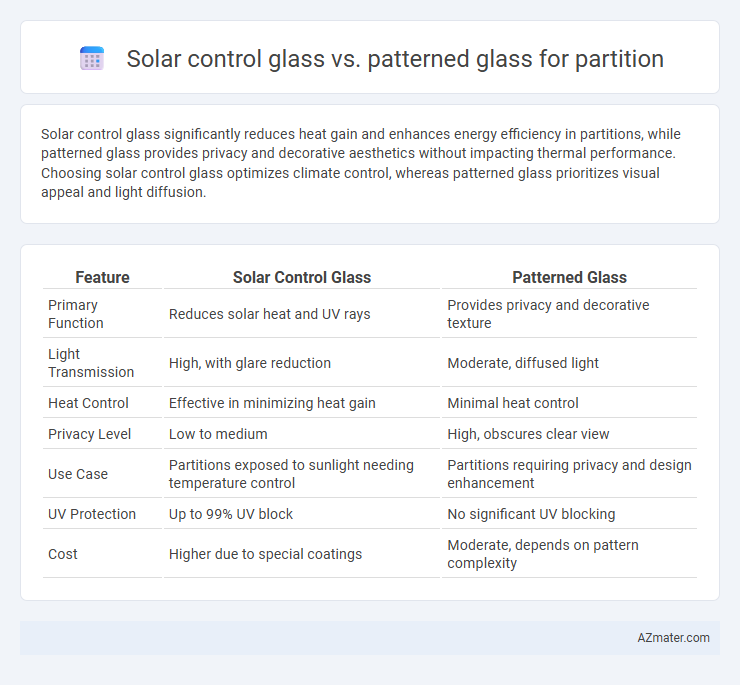Solar control glass significantly reduces heat gain and enhances energy efficiency in partitions, while patterned glass provides privacy and decorative aesthetics without impacting thermal performance. Choosing solar control glass optimizes climate control, whereas patterned glass prioritizes visual appeal and light diffusion.
Table of Comparison
| Feature | Solar Control Glass | Patterned Glass |
|---|---|---|
| Primary Function | Reduces solar heat and UV rays | Provides privacy and decorative texture |
| Light Transmission | High, with glare reduction | Moderate, diffused light |
| Heat Control | Effective in minimizing heat gain | Minimal heat control |
| Privacy Level | Low to medium | High, obscures clear view |
| Use Case | Partitions exposed to sunlight needing temperature control | Partitions requiring privacy and design enhancement |
| UV Protection | Up to 99% UV block | No significant UV blocking |
| Cost | Higher due to special coatings | Moderate, depends on pattern complexity |
Introduction to Glass Partitions
Glass partitions enhance office spaces by combining transparency with functionality, offering modern aesthetics and space division. Solar control glass optimizes energy efficiency by reducing heat gain and glare, improving indoor comfort and lowering cooling costs. Patterned glass provides privacy and decorative appeal with varied textures, making it ideal for areas requiring subtle separation without sacrificing natural light.
What is Solar Control Glass?
Solar control glass is designed to reduce heat gain by reflecting and absorbing solar radiation, making it ideal for energy-efficient partitions in offices and commercial spaces. This glass type enhances thermal comfort and minimizes glare without compromising natural light, contributing to lower cooling costs and improved indoor environments. Patterned glass, while offering decorative privacy and diffused light, lacks the advanced thermal insulation properties of solar control glass.
What is Patterned Glass?
Patterned glass features textured or embossed surfaces that enhance privacy and diffuse light without completely blocking visibility, making it ideal for partitions where aesthetic appeal and partial translucency are desired. Unlike solar control glass, which is designed to reduce heat and glare by reflecting and absorbing solar radiation, patterned glass focuses on creating visual interest and obscuring direct sightlines. This type of glass is commonly used in office partitions and bathroom enclosures where both style and functionality are important.
Key Differences Between Solar Control and Patterned Glass
Solar control glass is designed with special coatings that reflect and absorb solar radiation, significantly reducing heat gain and UV penetration, making it ideal for energy-efficient partitions. Patterned glass, on the other hand, features textured surfaces that provide privacy and diffuse light while allowing moderate visibility, without specific thermal control properties. The key difference lies in solar control glass's ability to enhance thermal insulation and energy savings, whereas patterned glass primarily offers aesthetic appeal and privacy.
Advantages of Solar Control Glass for Partitions
Solar control glass for partitions offers superior energy efficiency by reducing heat gain and minimizing glare, enhancing indoor comfort and productivity. Its UV protection properties safeguard furniture and interiors from fading, extending their lifespan. Compared to patterned glass, solar control glass maintains clear visibility while providing effective thermal insulation, making it ideal for modern office and residential spaces.
Benefits of Patterned Glass in Partition Applications
Patterned glass offers enhanced privacy and aesthetic appeal in partition applications by obscuring visibility while allowing light to pass through, creating a bright yet private environment. Its textured surfaces reduce glare and fingerprints, maintaining a clean, professional look in office or commercial spaces. Unlike solar control glass, patterned glass does not require coatings or films, making it a low-maintenance option that also contributes to improved sound insulation.
Privacy and Light Management Comparison
Solar control glass offers superior light management by reducing glare and heat transmission, making it ideal for maintaining a bright yet comfortable environment in partitions. Patterned glass enhances privacy through intricate designs and textures that obscure visibility while still allowing diffused natural light to pass through. For optimal balance, solar control glass excels in energy efficiency and glare reduction, whereas patterned glass prioritizes visual privacy without significantly compromising light diffusion.
Aesthetic Considerations for Modern Interiors
Solar control glass enhances modern interiors by offering sleek, transparent partitions that reduce glare and heat while maintaining natural light, creating a minimalist and sophisticated aesthetic. Patterned glass introduces texture and visual interest through various designs and finishes, adding character and privacy without sacrificing light transmission. Both options contribute uniquely to contemporary spaces, with solar control glass emphasizing functionality and clarity, and patterned glass focusing on decorative appeal and subtle diffusion.
Cost and Installation Factors
Solar control glass typically incurs higher initial costs compared to patterned glass due to advanced coatings that enhance energy efficiency and reduce glare. Installation of solar control glass may require specialized handling to preserve its functional coatings, potentially increasing labor expenses. Patterned glass offers a more cost-effective and easier installation option, with textured surfaces that provide privacy without the need for additional treatments or complex mounting techniques.
Choosing the Right Glass for Your Partition Needs
Solar control glass enhances energy efficiency by reducing heat gain and UV radiation, making it ideal for partitions in sun-exposed areas. Patterned glass offers privacy and decorative appeal with textured designs that obscure visibility while allowing light transmission. Selecting the right glass depends on balancing factors like thermal performance, privacy requirements, and aesthetic preferences for optimal partition functionality.

Infographic: Solar control glass vs Patterned glass for Partition
 azmater.com
azmater.com